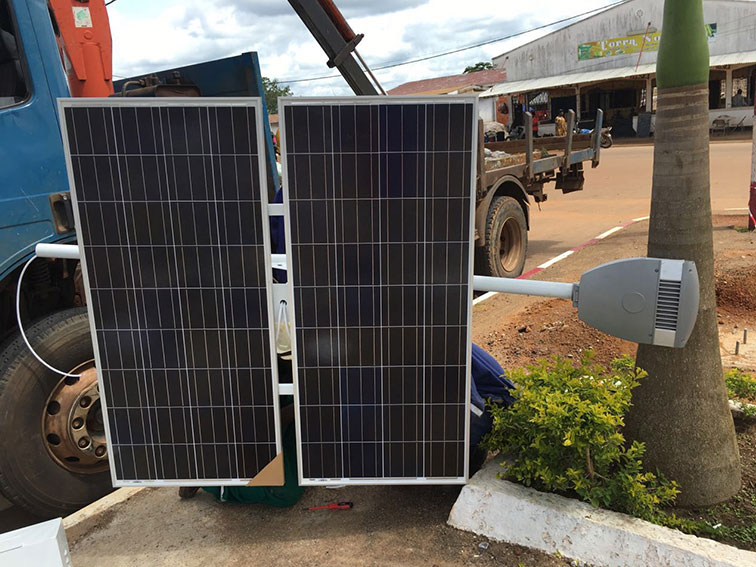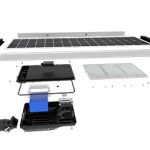12 Key Points for Designing and Constructing Solar Street Lights

What parameters are often involved in designing and constructing solar street lights? How to determine?
designing and constructing solar street lights
Different installation environments have different requirements for solar street lights, so the configuration of solar street lights is naturally different, such as home outdoor lighting and road lighting, such as main roads and secondary roads, which are all different, so when installing solar street lights , which parameters are often involved? Let’s take a look at them in detail below.
System rated voltage
That is the rated voltage of the battery. The voltage of a single solar cell is generally 0.4~0.7V. A common solar cell module is 36/54/60/72/96 cells connected in series, and the voltage is 18/27/30/36/ Around 48 volts.

local solar radiation
You can check this directly online and select the monthly average radiation amount at the best angle. The minimum three-month average is required. When installing, you must also pay attention to the installation angle and direction to ensure that the solar street lights can receive sufficient sunlight. , to ensure charging efficiency, depending on the specific environment, the range of ±20° due south is a better location.
Rainy day compensation
This depends on the local climate conditions. The charging efficiency of the solar cell cover on cloudy and rainy days is naturally not as good as that on sunny days. Then it is necessary to ensure that the battery can store enough power so that the solar street lights can be used normally on rainy days. This also affects the efficiency of the panel.
Interval between consecutive rainy days
That is, the number of sunny days between two consecutive rainy days. It should be noted here that when calculating relevant parameters, the average sunshine is generally used as the basis for supplementary charging on sunny days. The actual amount of irradiation on sunny days is greater than the average sunshine.
Moreover, there is not completely no power to charge the battery on rainy days, so when calculating, you need to use this parameter. There is no need to actually select the interval between consecutive rainy days. You can appropriately enlarge the value. The value of the interval between rainy days and rainy days. The ratio of 1:3 or 1:4 is more suitable.
Solar panel output power
Solar panels are generally composed of multiple solar unit cells connected in series. Its capacity depends on the total power consumed by the lighting source, line transmission components, and local solar radiation energy.
Under normal circumstances, the output power of solar panels should be more than 3 to 5 times the light source power. In areas with abundant light and short lighting time, it should be more than 3 to 4 times. In areas with poor lighting conditions and long lighting time, it should be 4 times. ~More than 5 times.
LED lamp head power
That is, the power of the lamp head or the driving efficiency of the controller, which is determined according to the specific installation environment. The higher the lamp pole, the higher the lighting effect, the higher the power requirements of the lamp head.
Daily load working hours
Today’s solar street lights are all intelligently designed. They are generally brighter at night when it is more lively. At this time, they usually work at 100% full power. When it is quiet at night, the brightness is smaller, and they may only work at 50% power. When calculating, the equivalent working time of full power must be considered.
Controller component charging efficiency
There are generally two types of controller charging control methods: PWM and MPPT. The corresponding charging efficiencies of these two types are different. PWM has three-stage charging methods: strong charge, balanced charge, and float charge, which can well solve the problem of battery dissatisfaction. It has the problem of short service life, but its charging efficiency is not as good as MPPT.
The MPPT solar controller charging stage is divided into MPPT charging, constant voltage equalizing charging and constant voltage floating charging stages, which allows the system to always charge the battery at maximum power, so the charging efficiency is also very high, and the price is several times or even several times that of PWM. Ten times, you still have to base it on your own needs, and the relevant parameters just depend on the specific components.
Controller component drive efficiency
It serves as a reference for calculating the lamp head power and setting the lamp head driving current.
Battery conversion efficiency
Different batteries have different efficiencies. Nowadays, solar street lights are generally integrated in design. The matching lithium iron phosphate battery has a conversion efficiency much higher than that of the previous lead-acid batteries, generally between 92% and 95%. between.
Battery capacity
The size of the battery capacity is also a key point to pay attention to. If the capacity is too small, it cannot meet the lighting needs at night; if the capacity is too large, the battery will always be in a state of power loss, which will cause waste and affect the battery life.
The ratio of battery capacity (Ah) to load capacity (Ah) should be more than 3 to 6 times. If the installation area has fewer continuous rainy days, 3 to 4 times or more is enough. If there are many continuous rainy days, then at least 3 to 4 times is enough. 5 to 6 times more.
Comprehensive loss compensation coefficient
This generally takes into account line loss, dust, shadow occlusion, battery Coulomb efficiency, and some effects caused by temperature. When calculating relevant parameters, the value is generally between 1 and 1.4.
Other parameters involved include the cumulative battery discharge depth. For commonly used lithium batteries, it is recommended that the discharge depth be around 90%. Understanding these parameters can help merchants better understand customer needs and select configurations suitable for the installation environment.
Author

ZGSM Solar
We are a professional solar street light manufacturer with a 20-year history.






